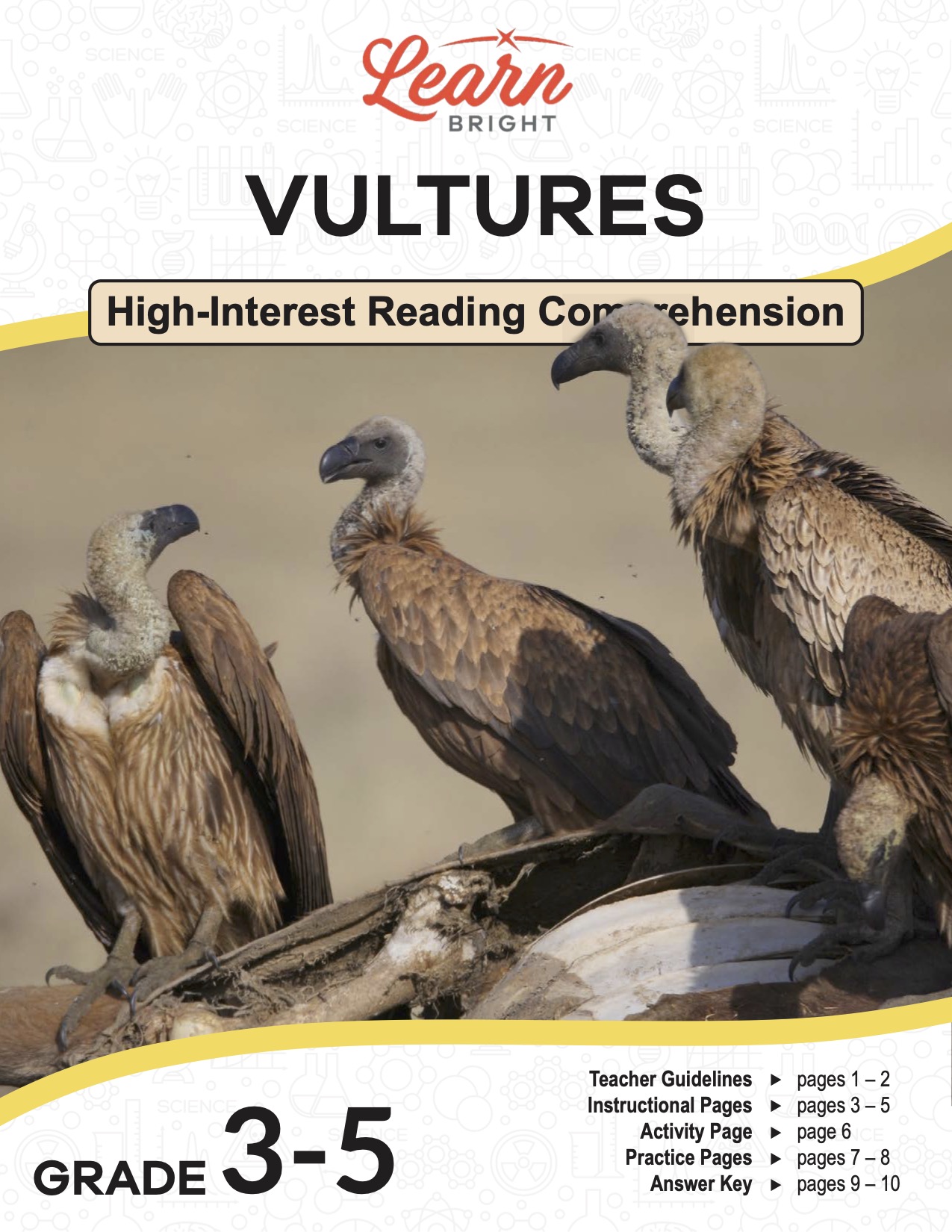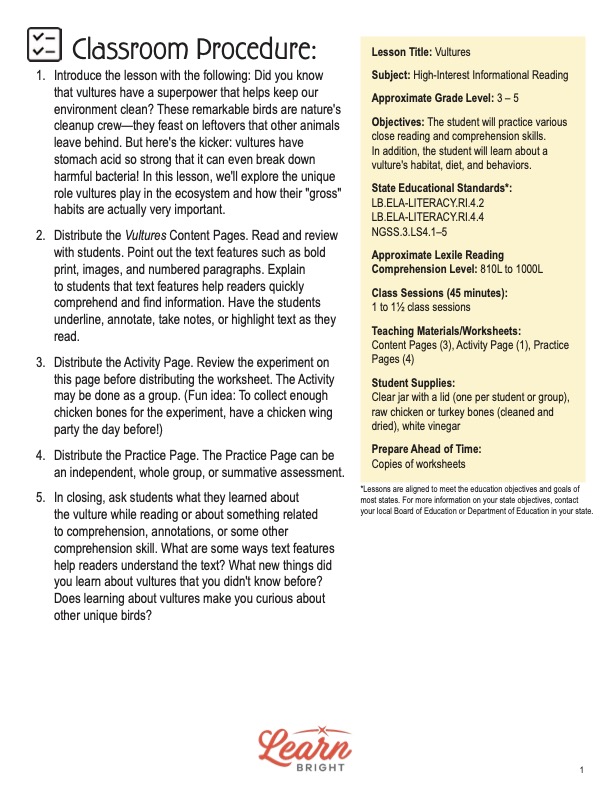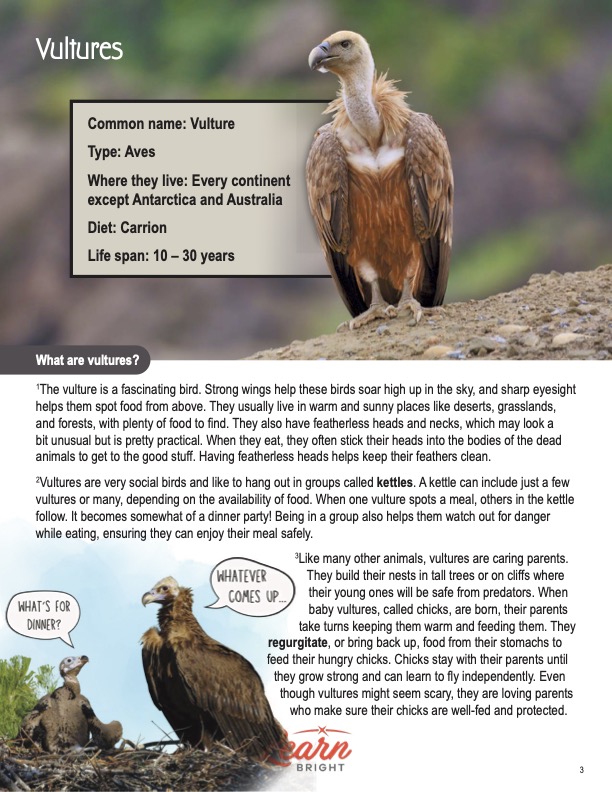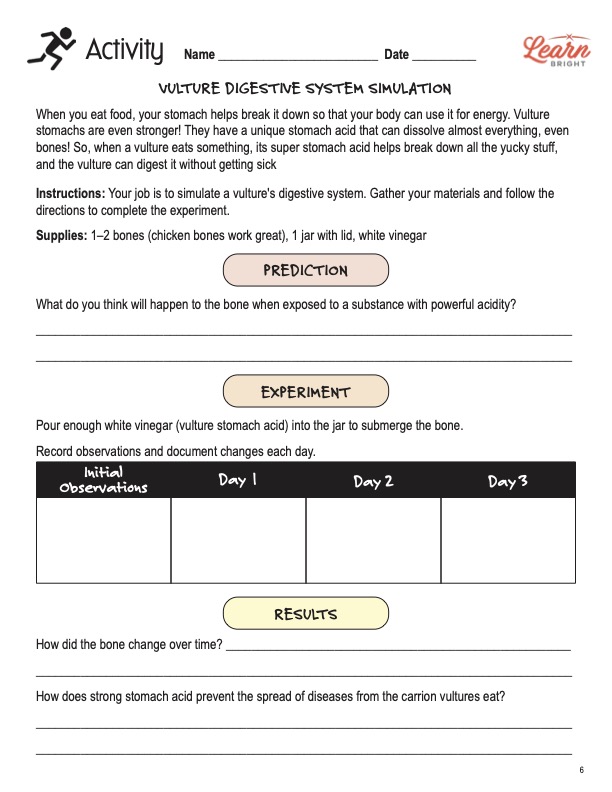Description
What our Vultures lesson plan includes
Lesson Objectives and Overview: Vultures is a high-interest reading comprehension lesson plan. As such, students will practice various close reading and comprehension skills. In addition, they will learn about the habitat, diet, and behaviors of a vulture. This lesson is for students in 3rd grade, 4th grade, and 5th grade.
Classroom Procedure
Every lesson plan provides you with a classroom procedure page that outlines a step-by-step guide to follow. You do not have to follow the guide exactly. The guide helps you organize the lesson and details when to hand out worksheets. It also lists information in the yellow box that you might find useful. You will find the lesson objectives, state standards, and number of class sessions the lesson should take to complete in this area. In addition, it describes the supplies you will need as well as what and how you need to prepare beforehand. For this lesson, you need clear jars with a lid (one per student or group), raw chicken or turkey bones (cleaned and dried), and white vinegar.
Teacher Notes
The paragraph on this page gives you a little more information on the lesson overall and describes what you may want to focus your teaching on. It explains that you can teach this lesson in a whole-class setting or as an independent, small-group activity. The blank lines are available for you to write out any thoughts or ideas you have as you prepare.
VULTURES LESSON PLAN CONTENT PAGES
What Is a Vulture?
The Vultures lesson plan contains three content pages. It begins by providing a box of background information about this bird. Vultures live on almost every continent on the planet except for Antarctica and Australia. They feed on carrion, which makes them carnivores. They live between 10 and 13 years.
The vulture is a fascinating bird. Strong wings help these birds soar high up in the sky, and sharp eyesight helps them spot food from above. They usually live in warm and sunny places like deserts, grasslands, and forests, with plenty of food to find. They also have featherless heads and necks, which may look a bit unusual but is pretty practical. When they eat, they often stick their heads into the bodies of the dead animals to get to the good stuff. Having featherless heads helps keep their feathers clean.
Vultures are very social birds and like to hang out in groups called kettles. A kettle can include just a few vultures or many, depending on the availability of food. When one vulture spots a meal, others in the kettle follow. It becomes somewhat of a dinner party! Being in a group also helps them watch out for danger while eating, ensuring they can enjoy their meal safely.
Like many other animals, vultures are caring parents. They build their nests in tall trees or on cliffs where their young ones will be safe from predators. When baby vultures, called chicks, are born, their parents take turns keeping them warm and feeding them. They regurgitate, or bring back up, food from their stomachs to feed their hungry chicks. Chicks stay with their parents until they grow strong and can learn to fly independently. Even though vultures might seem scary, they are loving parents who make sure their chicks are well-fed and protected.
Diet of a Vulture
To help keep the environment tidy and safe, vultures have the critical responsibility of taking care of the leftovers, so to speak. They mainly eat carrion, a fancy word for the bodies of animals that have already passed away. Think about times when you help your family recycle paper, plastic, and cans to keep your home clean and protect the earth. Vultures do something similar, but with animals instead.
Imagine if there were no vultures! Animal remains would pile up, which could be a big problem. The decaying animals would make the environment messy and could easily spread diseases. Vultures find these dead animals and consume them so that they don’t go to waste. They turn them into essential nutrients that return to Earth. It’s like a natural recycling system that helps everything in the wild stay healthy and balanced.
How vultures find their meals is pretty cool. They have some remarkable adaptations. For one, they have excellent eyesight that helps them spot carrion from way high up in the sky. They can also smell really well, which makes it easy to detect the smell of dead animals, even from a distance.
When a vulture finds a meal, it usually lands next to it and uses its sharp beak to tear into the carcass (the dead animal’s body) and get to the meat. Vultures don’t really have to catch their meals as lions or eagles do. Instead, they get to find animals that are already gone and help recycle them back into the ecosystem.
Other Interesting Vulture Facts
One other really cool adaptation helps vultures stay clean while eating their not-so-clean meals. Vultures are known for their bald heads and necks. You might wonder why that matters. Well, when vultures dig into a meal, such as a leftover animal, they can get messy stuff on their faces. But because they have bald heads, it’s super easy for them to stay tidy. They can quickly clean their heads after eating, just like when you wipe your face with a napkin. This neat trick keeps them hygienic and healthy while doing their job in the wild.
The scientific name for vultures, Cathartidae, means purifier because vultures clean the environment by eating carrion. But cleaning up isn’t the only thing they’re good at. Vultures are excellent fliers. They use warm air currents called thermals to soar high up in the sky without flapping their wings too much. This is known as thermalling. This unique behavior helps them cover vast areas in search of food without exerting too much energy.
Vultures have fantastic eyesight, as you now know, which helps them spot carrion from high above. Their vision is so sharp that they can see small details on the ground while soaring in the sky. What a superpower! Their eyes are like a pair of binoculars. Such keen eyesight allows them to find food quickly and efficiently. It is this superpower that allows them to thrive in their scavenger lifestyle.
Why They Are Important
Vultures are janitors in their wild world. They play a significant role in the environment by eating animals that have passed away, consuming roadkill or the remains of animals in the wild. This helps prevent these carcasses from spreading diseases and keeps the environment clean. Vultures are much like nature’s recycling team. By removing dead animals, they help maintain a healthy balance in the ecosystem. They ensure nothing goes to waste, and their work benefits all the animals and plants that share their habitat.
While some vultures are thriving, other species are facing challenges. In certain places, vultures are threatened by habitat loss and chemical poisoning. However, they are not all endangered. Some species are doing okay, but looking out for those in trouble is important. Scientists and conservationists are working hard to protect vultures and their habitats. So, while vultures might be facing some problems, there’s hope that with our help, they can continue their vital work in the world.
VULTURES LESSON PLAN WORKSHEETS
The Vultures lesson plan includes two worksheets: an activity worksheet and a practice worksheet. Each one will help students solidify their grasp of the material they learned throughout the lesson. You can refer to the classroom procedure guidelines to know when to hand out each worksheet.
DIGESTIVE SYSTEM SIMULATION ACTIVITY WORKSHEET
For the activity, students will simulate a vulture’s digestive system. They will use the materials you provide to conduct the experiment. Throughout the simulation, students will answer the prompts on the worksheet page and write their observations and results.
VULTURES PRACTICE WORKSHEET
The practice worksheet lists 11 questions based on the content. These questions all relate to the content pages, so students will need to refer to them often for the answers. In addition, each question provides which reading tool the question corresponds to, such as text feature, vocabulary, or comprehension.
Worksheet Answer Keys
At the end of the lesson plan document is an answer key for the practice worksheet. The correct answers are all in red to make it easier for you to compare them with students’ responses. If you choose to administer the lesson pages to your students via PDF, you will need to save a new file that omits these pages. Otherwise, you can simply print out the applicable pages and keep these as reference for yourself when grading assignments.










